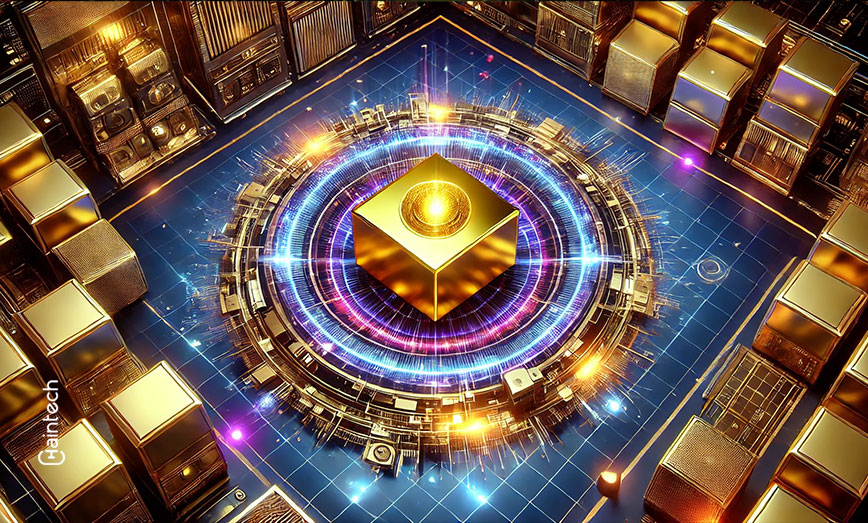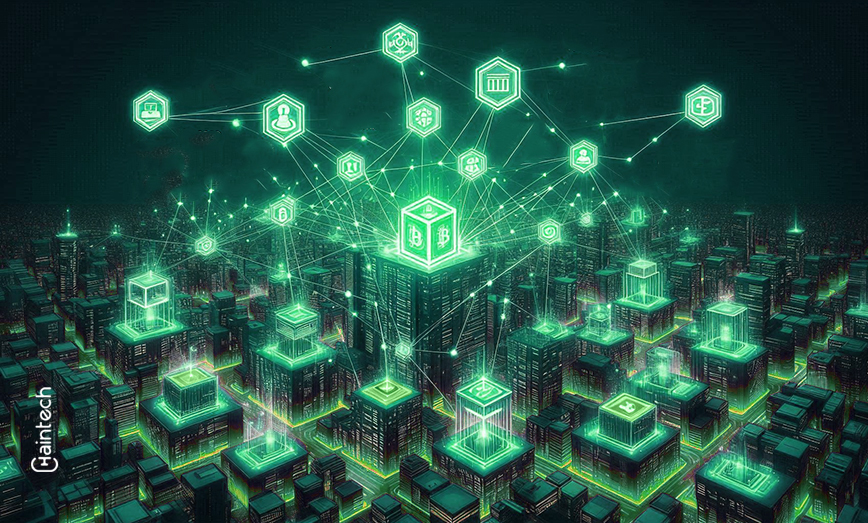UBS Tests Blockchain to Democratize Digital Gold: Can IndiaŌĆÖs $1.5 Trillion Gold Market Go Digital?┬Ā

Gold has always been a favorite in Indian households. Now, UBS, a top global bank managing over $5.7 trillion, is testing blockchain technology for digital gold investments on ZKsync. This move could reshape how Indians buy, trade, and own gold.
A recent study shows IndiaŌĆÖs gold demand hit 797 Tonnes in 2023. With UBS blending blockchain and gold, even small investors might access secure, low-cost digital gold. LetŌĆÖs explore how this experiment works and its impact.
UBS Key4 Gold: A new way to own gold
UBS isnŌĆÖt just talking about innovation. As UBS tests blockchain with Key4 Gold, their digital gold product on ZKsync, traditional gold investing challenges like high fees and storage risks could become obsolete. Blockchain fixes this.
For example, buying gold through ETFs or physical dealers takes days. With UBSŌĆÖs system, transactions settle instantly. Imagine purchasing Ōé╣500 worth of gold during Diwali sales without delays. ZKsyncŌĆÖs tech ensures security while cutting costs.
Key Features of UBSŌĆÖs Blockchain Gold:
- Instant settlements: Trade gold 24/7 like cryptocurrencies.
- Low fees: Target of $0.0001 per transaction by 2025.
- Fractional ownership: Buy 0.01 grams of gold with Ōé╣10.
Unique Fact
ZKsyncŌĆÖs Validium technologyŌĆöused by UBS for its blockchain goldŌĆöconsumes 99% less energy than traditional proof-of-work blockchains. This makes it one of the most eco-friendly ways to trade digital assets, aligning with IndiaŌĆÖs push for sustainable finance under its COP26 commitments.
Why ZKsync? The tech behind UBSŌĆÖs plan
UBS tests blockchain on ZKsync for three reasons: speed, privacy, and cost efficiency. The networkŌĆÖs 2,000 TPS capability ensures seamless transactions during IndiaŌĆÖs gold-buying festivals. First, speed. ZKsync handles 2,000 transactions per second (TPS), aiming for 10,000 TPS by 2025. Second, privacy. Your data stays off-chain but is verified on Ethereum. Third, cost. Fees could drop 99% compared to traditional methods.
How It Works:
- You buy digital gold via UBSŌĆÖs platform.
- ZKsync processes the transaction off-chain.
- Proofs are stored on Ethereum for security.
This mix of speed and safety matters for India. With 15 crore crypto users, tech-savvy investors will likely adopt blockchain gold fast.
The technology behind ZKsync: Why it matters for India
UBSŌĆÖs choice of ZKsync isnŌĆÖt random. This Ethereum-based network uses ŌĆ£zero-knowledge proofs,ŌĆØ a method that validates transactions without revealing personal details. Think of it like a sealed envelopeŌĆöbanks verify the contents without opening it.
For India, this matters. With rising cyber threats, privacy-focused tech builds trust. ZKsync also handles 2,000 transactions per second today but targets 10,000 TPS by 2025. During festivals like Dhanteras, when gold demand spikes, such speed prevents crashes. Small investors benefit most.
A farmer in Punjab can buy Ōé╣100 worth of gold during lunch breaks, avoiding bank queues. Traditional systems canŌĆÖt match this. However, internet access remains a hurdle. Only 52% of rural India uses the internet daily. UBS must partner with local telecoms to bridge this gap.
Impact on India: Gold for the masses
India holds 25,000 tons of gold in households. Yet, many avoid formal channels due to high costs. UBSŌĆÖs blockchain gold could change this.
Benefits for Indian investors:
- Lower entry barriers: Start with Ōé╣100 instead of Ōé╣50,000.
- No locker risks: Digital gold stays safe on blockchain.
- Liquidity: Sell gold instantly during price spikes.
Research by the World Gold Council shows 65% of Indians prefer gold for emergencies. Blockchain makes it easier to liquidate holdings during crises.
Challenges: Will India embrace blockchain gold?
UBS faces roadblocks. First, Indians trust physical gold. Convincing them to switch to digital needs education. Second, regulations. IndiaŌĆÖs crypto taxes and unclear blockchain laws could slow adoption. Third, tech literacy. Only 45% of rural India uses smartphones.
Comparison: Digital Gold vs. Physical Gold
| Factor | Physical Gold | UBS Digital Gold |
| Storage | Lockers (Ōé╣2,000/year) | Blockchain (Free) |
| Transaction Time | 3-5 days | Instant |
| Minimum Buy | 1 gram (~Ōé╣6,500) | Ōé╣10 |
| Liquidity | Low (Jeweler dependent) | High (Instant sale) |
Competing with Indian digital gold platforms
India already has digital gold platforms like Paytm Gold and SafeGold. How is UBS different? Existing services rely on centralized systems. They hold gold in vaults and issue digital certificates. UBSŌĆÖs blockchain model cuts middlemen. No vault fees. No delays. For instance, selling gold on Paytm takes 24 hours. With UBS, itŌĆÖs instant. Prices also stay competitive. Traditional platforms add 3-5% making charges.
Blockchain slashes this to near zero. But challenges remain. Paytm Gold integrates with UPIŌĆöa feature UBS lacks. Indian users love UPIŌĆÖs simplicity. If UBS adds UPI support, adoption could soar. Another edge? Transparency. Blockchain lets users track goldŌĆÖs origin, addressing purity concerns common in local markets.
Did You Know?
IndiaŌĆÖs 2015 Gold Monetization Scheme aimed to mobilize 22,000 tons of idle household gold into banks. UBSŌĆÖs blockchain solution could finally crack this code by letting Indians earn interest on digital gold without parting with physical assetsŌĆöa game-changer for a nation sitting on $1.5 trillion of buried gold.
Regulatory hurdles and the road ahead
IndiaŌĆÖs strict crypto laws could slow UBSŌĆÖs plans. The 1% TDS on virtual assets applies here. If classified as a ŌĆ£crypto asset,ŌĆØ digital gold faces taxes. However, the RBI has shown interest in blockchain. In 2023, it tested a digital rupee for wholesale transactions. UBS might collaborate with Indian banks. Imagine SBI offering blockchain gold via the YONO app. This would ease trust issues.
However, RBI guidelines are unclear. Will blockchain gold fall under SEBI, RBI, or neither? Clarity is key. For now, UBS is testing quietly. A Mumbai-based financial analyst, Riya Mehta, says, ŌĆ£Indians wonŌĆÖt abandon physical gold overnight. But if UBS offers 24-karat assurance and Diwali discounts, theyŌĆÖll listen.ŌĆØ The game has just begun.
Conclusion
India loves gold. UBS tests blockchain might make this love affair smarter, cheaper, and safer. For young investors, this means gold in their demat accounts. For families, itŌĆÖs a modern twist on tradition. Stay updated on UBSŌĆÖs blockchain gold. Your next investment could be a tap away.
FAQs
- Is UBSŌĆÖs digital gold safe?
Yes. Stored on a blockchain with EthereumŌĆÖs security.
- Can I convert digital gold to physical?
UBS hasnŌĆÖt confirmed yet. Likely through partners.
- Will GST apply to blockchain gold?
Depends on Indian laws. Currently, digital assets face 1% TDS.
- How to start investing?
Waiting for the official launch. Sign up on UBS IndiaŌĆÖs platform.
- What if ZKsync fails?
Funds remain secure on Ethereum.









